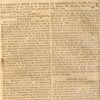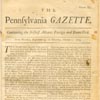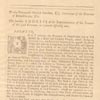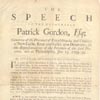
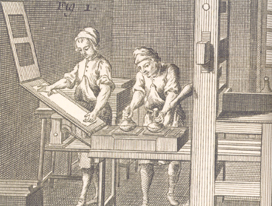
"L'Operation d'Imprimer" [detail], engraving in Denis Diderot et al., Encylopedie, ou, Dictionnaire Raisonne des Sciences, des Arts et des Metiers, Paris, 1761-1789.
Section 2: The Printer as Entrepreneur
Every step of Benjamin Franklin’s way to wealth as printer in Philadelphia was taken at the expense of one or the other of his two great rivals, first his employer Samuel Keimer, whose business he undermined and then supplanted, and then Andrew Bradford, a far more formidable rival, who had been the only printer in Pennsylvania, before Keimer’s arrival. Bradford and his father William in New York together had enjoyed a monopoly on all the offices and functions necessary for success as a colonial printer: newspaper and almanac publisher, postmaster, government printer, job printer, stationer, wholesale paper merchant, book publisher, retail and wholesale bookseller. One after another of these monopolies Franklin either broke or usurped, but in every instance, he expanded or improved upon what the Bradfords had done, and made all these parts work together in a dynamic business system. He became the most purely entrepreneurial of all colonial printers.
Keimer’s Credit and Business declining daily, he was at last forc’d to sell his Printing-House…. There remain’d now no Competitor with me at Philadelphia, but the old one, Bradford, who was rich and easy, did a little Printing now and then by straggling Hands, but was not very anxious about the Business. However, as he kept the Post Office, it was imagined he had better Opportunities of obtaining News, his Paper was thought a better Distributer of Advertisements than mine, and therefore had many more, which was a profitable thing to him and a Disadvantage to me… In 1737. the Postmaster General, being dissatisfied [with Bradford] respecting some Negligence in rendering, and Inexactitude of his Accounts, took from him the Commission and offered it to me. I accepted it readily … for tho’ the Salary was small, it facilitated the Correspondence that improv’d my Newspaper, increas’d the Number demanded, as well as the Advertisements to be inserted, so that it came to afford me a very considerable Income. My old Competitor’s Newspaper declin’d proportionably.
Benjamin Franklin, Autobiography
Samuel Keimer’s Elegy on the Death of Aquila Rose: Benjamin Franklin’s first known Philadelphia printing job, 1723 (Philadelphia: Carmen D. Valentino Rare Books and Manuscripts, Catalogue 50, 2000).
Franklin’s first master in Philadelphia was Samuel Keimer, who was “a mere Compositor, knowing nothing of Presswork.” On his first day on the job, Franklin printed this elegy, which Keimer had composed directly in type. The only known copy recently came to light in a private collection.
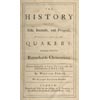 William Sewel, The History of the Rise, Increase, and Progress, of the Christian People called Quakers, third edition, corrected (Philadelphia: Printed and Sold by Samuel Keimer [and Franklin and Meredith], 1728).
William Sewel, The History of the Rise, Increase, and Progress, of the Christian People called Quakers, third edition, corrected (Philadelphia: Printed and Sold by Samuel Keimer [and Franklin and Meredith], 1728).
Keimer was commissioned by the Friends to reprint this book, a job too big for him to handle. In 1728 Franklin left Keimer’s employ, set up his own shop, convinced the Friends to turn the job over to him, and finished off the last forty-four and a half sheets (178 pages) of the book in a matter of weeks. Thus Franklin got his start by stealing a job from his former boss.
The Pennsylvania Gazette (Philadelphia: Printed by Samuel Keimer, September 25, 1729); and (Philadelphia: Printed by B. Franklin and H. Meredith, at the New Printing-Office near the Market, October 2, 1729). Keimer’s last issue is on the left, and Franklin and Meredith’s first on the right.
Keimer launched the Pennsylvania Gazette in 1728. It was a dull paper and Franklin satirized it in Bradford’s paper under the pseudonym “The Busy-Body.” Its circulation fell and Franklin was able to buy it for a trifle. Thus he used one competitor’s newspaper to help destroy the other’s.
Pennsylvania General Assembly, To the Honourable Patrick Gordon [March 29, 1729] [Philadelphia: Andrew Bradford, 1729]. Historical Society of Pennsylvania. (left image)
Pennsylvania General Assembly, The Speech of the Honourable Patrick Gordon, Esq. [January 13, 1730] [Philadelphia: Franklin and Meredith, 1730]. Historical Society of Pennsylvania.
(right image)
Franklin got the job of printer to the Assembly by reprinting “elegantly and correctly” a speech by the governor that Bradford had printed in a “coarse blundering manner.” Franklin’s reprint does not survive, but a similar job he printed for the Assembly soon after shows his superior presswork.
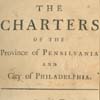 Pennsylvania General Assembly, A Collection of all the Laws of the Province of Pennsylvania: Now in Force (Philadelphia: Printed and Sold by B. Franklin, 1742).
Pennsylvania General Assembly, A Collection of all the Laws of the Province of Pennsylvania: Now in Force (Philadelphia: Printed and Sold by B. Franklin, 1742).
Printing the Votes and Laws of the Assembly was steady work, but even more profitable was the job of printing this cumulation of the laws in 1742, one of Franklin’s largest books.
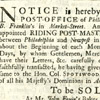 “Notice is hereby given, that the Post Office of Philadelphia, is now kept at B. Franklin’s,” Pennsylvania Gazette (Philadelphia: Printed by B. Franklin, November 3, 1737).
“Notice is hereby given, that the Post Office of Philadelphia, is now kept at B. Franklin’s,” Pennsylvania Gazette (Philadelphia: Printed by B. Franklin, November 3, 1737).
Getting the postmastership away from Bradford was in the long run just as important as getting the government printing.
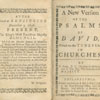 N[icholas] Brady and N[ahum] Tate, A New Version of the Psalms (Philadelphia: Printed and sold by B. Franklin. Sold also by A. Bradford, 1733). Historical Society of Pennsylvania.
N[icholas] Brady and N[ahum] Tate, A New Version of the Psalms (Philadelphia: Printed and sold by B. Franklin. Sold also by A. Bradford, 1733). Historical Society of Pennsylvania.
Because of the Bradford family monopoly on the output of the Rittenhouse paper mill, Franklin had to use imported paper in all his books but this one, which he shared with Bradford just to get the paper to print it with. A few months later he set up a mill of his own and went on to became the largest paper wholesaler in the colonies.
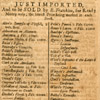 “Just Imported, and to be Sold by B. Franklin,” Pennsylvania Gazette. (Philadelphia: Printed by B. Franklin, June 1, 1738.)
“Just Imported, and to be Sold by B. Franklin,” Pennsylvania Gazette. (Philadelphia: Printed by B. Franklin, June 1, 1738.)
When Franklin first came to Philadelphia, Bradford’s was the only bookstore in town, and he was really a stationer, selling paper, almanacs, ballads, and primers. In 1738 Franklin began steadily to import books from London, and by the time he retired, his was the largest book store in America.
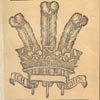 The General Magazine, and Historical Chronicle, Vol. I (Philadelphia: Printed and Sold by B. Franklin, January 1741).
The General Magazine, and Historical Chronicle, Vol. I (Philadelphia: Printed and Sold by B. Franklin, January 1741).
In 1741 both Franklin and Bradford began to publish monthly magazines, the first in the colonies. Both failed after a few issues. This was the last battle between the two rivals. Bradford died in 1742, and Franklin became the city’s leading printer, a position he never relinquished.
